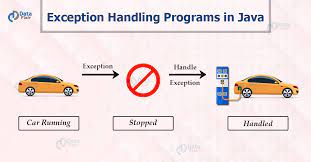Exception Handling is the process of responding to the occurrence of exceptions – anomalous or exceptional conditions requiring special processing – during the execution of a program. In general, an exception breaks the normal flow of execution and executes a pre-registered exception handler; the details of how this is done depend on whether it is a hardware or software exception and how the software exception is implemented.
Exception handling, if provided, is facilitated by specialized programming language constructs, hardware mechanisms like interrupts, or operating system (OS) inter-process communication (IPC) facilities like signals. Some exceptions, especially hardware ones, may be handled so gracefully that execution can resume where it was interrupted.
An alternative approach to exception handling in software is error checking, which maintains normal program flow with later explicit checks for contingencies reported using special return values, an auxiliary global variable such as C‘s errno, or floating point status flags. Input validation, which preemptively filters exceptional cases, is also an approach.
Exception handling in the IEEE 754 floating point hardware standard refers in general to exceptional conditions and defines an exception as “an event that occurs when an operation on some particular operands has no outcome suitable for every reasonable application. That operation might signal one or more exceptions by invoking the default or, if explicitly requested, a language-defined alternate handling.”
What are the types of exception handling?
- Arithmetic Exception.
- Array Index Out Of Bounds Exception.
- Class Not Found Exception.
- File Not Found Exception.
- IO Exception.
- Interrupted Exception.
- No Such Field Exception.
- No Such Method Exception.
Why exception handling is needed?
Java exception handling is important because it helps maintain the normal, desired flow of the program even when unexpected events occur. If Java exceptions are not handled, programs may crash or requests may fail. This can be very frustrating for customers and if it happens repeatedly, you could lose those customers.
What are the advantages of exception handling?
Separating Error-Handling Code from “Regular” Code. Exceptions provide the means to separate the details of what to do when something out of the ordinary happens from the main logic of a program. In traditional programming, error detection, reporting, and handling often lead to confusing spaghetti code.
What happens if exceptions are not handle?
When an exception occurred, if you don’t handle it, the program terminates abruptly and the code past the line that caused the exception will not get executed.
How would you handle the exception using try and catch?
Place any code statements that might raise or throw an exception in a try block, and place statements used to handle the exception or exceptions in one or more catch blocks below the try block. Each catch block includes the exception type and can contain additional statements needed to handle that exception type.
Which keyword is use to handle an exception?
The “throw” keyword is use to throw an exception. The “throws” keyword is use to declare exceptions.
Can we throw an exception manually?
You can throw a user defined exception or, a predefined exception explicitly using the throw keyword. To throw an exception explicitly you need to instantiate the class of it and throw its object using the throw keyword.
What are the methods of handling exception in java?
Customized Exception Handling : Java exception handling is managing via five keywords: try, catch, throw, throws, and finally. Briefly, here is how they work. Program statements that you think can raise exceptions are containing within a try block. If an exception occurs within the try block, it is throw.
What is an exception specification?
Exception specifications are a C++ language feature that indicate the programmer’s intent about the exception types, that can propagated by a function. The compiler can use this information to optimize calls to the function. And to terminate the program if an unexpected exception escapes the function.





